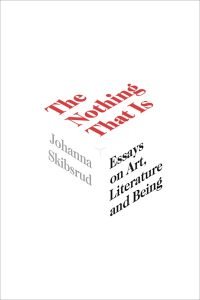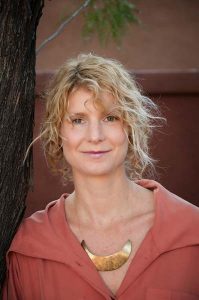Eye on the Indies: A Look at Indie Authors and Their Publishers
By Lanie Tankard, Indie Book Review Editor
The Nothing That Is: Essays on Art, Literature and Being by Johanna Skibsrud (Toronto: Book*hug Press, October 1, 2019 (Essais Series No. 9). 128 pages; $20.00; paperback original ISBN 9781771665261).
“Nothing will come of nothing: speak again.”— William Shakespeare, King Lear (Act I, Scene I)
 “Don’t think of an elephant!” warned George Lakoff, but then that’s all you can think about because the mere mention of an elephant has implanted the image in your brain. What if someone told you not to think about anything at all? Nada. Zip. Nothing.
“Don’t think of an elephant!” warned George Lakoff, but then that’s all you can think about because the mere mention of an elephant has implanted the image in your brain. What if someone told you not to think about anything at all? Nada. Zip. Nothing.
That’s what Johanna Skibsrud tried in her new book of eleven essays, The Nothing That Is, in which she records ten years of thoughts about the concept of “nothing.” The volume takes its title from the last line of a Wallace Stevens poem, “The Snow Man.” And Skibsrud’s work is nothing if not poetic.
Her approach is akin to the one French essayist Alain Corbin employed in his similarly slim volume Silence (reviewed here September 2018), yet Skibsrud’s is the more lyrical. Her microscopic lenses examine the slippery edges of nothing with sensitivity and insight, establishing graceful boundaries for the concept.
Skibsrud’s overarching theme is poiesis, a Greek philosophy term referring to the act of creation or making—how someone constructs something that did not exist before. Here, she juxtaposes poetry against the process of its creation.
How do truth and reality appear to poetry? Skibsrud climbs S.I. Hayakawa’s Ladder of Abstraction (from his classic book on general semantics, Language in Thought and Action) to examine concrete versus specific language. She reflects on nothing’s antonym, something, seeking to unearth “the thingly quality.” She considers negative numbers. She wants to know what it is that determines the absence of an object, while searching at the same time for “the grounds that give rise to the possibility of a figure.” Her method makes one think of M.C. Escher’s art as poetry.
She looks at “absence” through poet John Ashbery, bringing in deconstruction philosopher Jacques Derrida as well as Karl Marx. Then she takes on Virginia Woolf and Anne Carson via William James to “transcribe the waves.” Here she considers the limitations of words, looking at a blank page. Terry Tempest Williams, in her book When Women Were Birds (which I reviewed elsewhere), also tried to understand whether blank pages had a voice, when confronted with her mother’s empty journals after she died.
Skibsrud declares a “poetic emergency” in Objectivist poet George Oppen’s political and poetic thinking, noting how his language touches “upon the unsaid.” She crosses the borders of language as she looks at Erin Mouré’s poetry in O Cidadán, emphasizing the importance of making boundaries visible. There’s a fascinating essay on an electroencephalogram done on artist Gustav Metzger’s brain while he tried to think about nothing. The EEG was then turned into an art installation called Null Object.
Skibsrud considers poetry during a century of war in several essays. “Barbarians Among Us” was part of a 2014 lecture series at the Holocaust History Center in Tucson, Arizona. “If I Were Human” revises an earlier work.
In one piece, Skibsrud poses the question: Who has authority to speak and who is silenced? Here she responds to Muriel Rukeyser’s The Life of Poetry, discoursing about the creation of space for marginalized voices. She mentions poets who draw attention to silence and the way they do so, noting in particular how Chamoru (Chamorro) poet Craig Santos Perez includes blank space in his poetry and how it helps hidden words be heard. Perez is series editor of September’s “Eye on the Indies” selection, Indigenous Literatures from Micronesia, and coeditor of a forthcoming anthology called Geopoetics in Practice (out December 20 from Routledge).
Skibsrud’s essay “The Horror, The Horror” first appeared in the literary journal Brick. She addresses fake news, authentic images, and “false atrocity tales.” The piece is a thought-provoking discussion of fact and “falsity” festooned with implicit bias, wondering whether it’s actually documentation itself that has become unbelievable.

Photo: Dan Davis Photography
Skibsrud examines photography in particular, reconsidering Philippe Petit’s highwire act between the Twin Towers in light of Richard Drew’s 9/11 photo as she “Re-Floats” the Falling Man. She looks at the Abu Ghraib “hooded man” photo, going into mistaken ID, projection, and what one thinks one sees. She cites film director Errol Morris, who argues in his book Believing Is Seeing that “every photograph excludes something.”
Reflecting alongside such writers as Theodore Adorno, Walter Benjamin, Allen Ginsberg, Terrance Hayes, and Arthur Miller, Skibsrud explores the phrase “crimes against humanity.” She asks: How do we define and defend the borders of a human being? Noting how colonization dehumanizes the colonized, she opens a discussion of Others. Instead of redefining what human means, Skibsrud argues rather for an understanding of what current definitions leave out, going into the role of robotics. Throughout, Herodotus keeps appearing as a Greek chorus.
It’s worth reading Skibsrud’s wonderful 2009 debut novel, The Sentimentalists, as many of the ideas in these essays seem to have arisen there. In that fictional book, she explored empty spaces in the world, realizing there are not enough things to fill them: “No wonder that the cracks show.”
There’s nothing like The Nothing That Is. In these Essays on Art, Literature and Being, Johanna Skibsrud set herself a daunting task: To search for what hasn’t yet been imagined. And in doing so, she found nothing less than imaginative new ways of being.
Johanna Skibsrud is assistant professor of English at the University of Arizona, where she teaches twentieth-century literature and poetics. She is the author of five works of fiction (three novels and two short-story collections) as well as three books of poetry, and coauthor of a children’s book. The Nothing That Is, the title under review, is her first volume of essays.
Born in Scotsburn, Nova Scotia, Skibsrud holds a PhD in English literature from the Université de Montréal, an MA in English and Creative Writing from Concordia University in Montreal, and a BA in English literature from the University of Toronto.
Skibsrud’s debut novel, The Sentimentalists, won the 2010 Scotiabank Giller Prize. Her most recent novel, Island, came out in September from Hamish Hamilton. One of her two story collections, This Will Be Difficult to Explain, was shortlisted for the 2012 Danuta Gleed Literary Award from the Writers’ Union of Canada.
In 2017, her poetry collection The Description of the World received the Canadian Authors Association Award for Poetry, as well as the Fred Cogswell Award from the Royal City Literary Arts Society. It was shortlisted for the Pat Lowther Award from the League of Canadian Poets. Skibsrud’s other two poetry books also made shortlists: I Do Not Think that I Could Love a Human Being for the 2011 Atlantic Poetry Prize and Late Nights with Wild Cowboys for the 2009 Gerald Lampert Memorial Award (for a debut book of poetry) from the League of Canadian Poets.
Proceeds from a children’s book, Sometimes We Think You Are a Monkey coauthored with Sara Blacker, are donated to the Himalayan School Project.
Forthcoming in Spring 2020 is a critical monograph, The Poetic Imperative: A Speculative Aesthetics, from McGill-Queen’s University Press.
Publisher: Book*hug Press
 Book*hug Press in Toronto started out as BookThug in 2003, founded by co-owners and spouses Jay MillAr and Hazel Millar. The independent publisher began issuing poetry chapbooks the following year, gradually moving into translations and experimental works over the next fifteen years. In 2018, the press replaced the “T” in the company name with an asterisk to avoid controversy.
Book*hug Press in Toronto started out as BookThug in 2003, founded by co-owners and spouses Jay MillAr and Hazel Millar. The independent publisher began issuing poetry chapbooks the following year, gradually moving into translations and experimental works over the next fifteen years. In 2018, the press replaced the “T” in the company name with an asterisk to avoid controversy.
Publisher Jay MillAr’s poetry collections (some self-published) include I Could Have Pretended to Be Better Than You: New & Selected Poems (2019), Timely Irreverence (2013), Other Poems (2010), esp: Accumulation Sonnets (2009), Lack Lyrics (2008), The Small Blue: Poems (2007), False Maps for Other Creatures (2005), Mycological Studies (2002, shortlisted for the 2003 ReLit Poetry Prize), and The Ghosts of Jay MillAr (1998). He coauthored a microfiction novel with Stephen Cain (2006) titled Double Helix, and edited Haikube: History Machines (2006) by Gregory Betts (with Matt Donovan and Hallie Siegel). MillAr curates Apollinaire’s Bookshoppe, a virtual online bookstore. In addition, he has taught classes in poetry/poetics through his Toronto New School of Writing, which he founded in 2009.
Book*hug Managing Editor and Publicist Hazel Millar is current Chair of the Board for the Literary Press Group of Canada, as well as publicist for the League of Canadian Poets. MillAr and Millar, former students at York University in Toronto, have hosted a monthly reading salon series called HIJ.
The press seeks contemporary literary fiction and nonfiction, poetry, literature in translation, and drama (no children’s literature, genre fiction, cookbooks, or self-help books). “When acquiring manuscripts we carefully consider questions such as: whose voices are missing and who are the storytellers that we need most right now?”
This indie publisher is looking for bold, innovative books that take risks: “work that feels necessary and urgent…that challenges and pushes at the boundaries of cultural expectations.” Book*hug is “deeply committed to building a more inclusive CanLit by publishing culturally diverse voices whose work has been historically underrepresented in the publishing landscape. We strongly support feminist writing…and welcome work by indigenous writers, writers of colour, LGBTQ2S+ writers, deaf and disabled writers, and women.”
Submission guidelines are on the website.
Copyright 2019 Woven Tale Press LLC. All Rights Reserved
[/tm_pb_text][/tm_pb_column][/tm_pb_row][/tm_pb_section]

